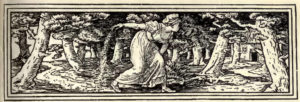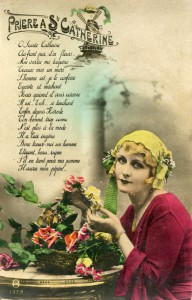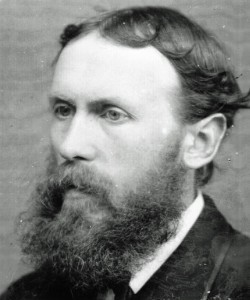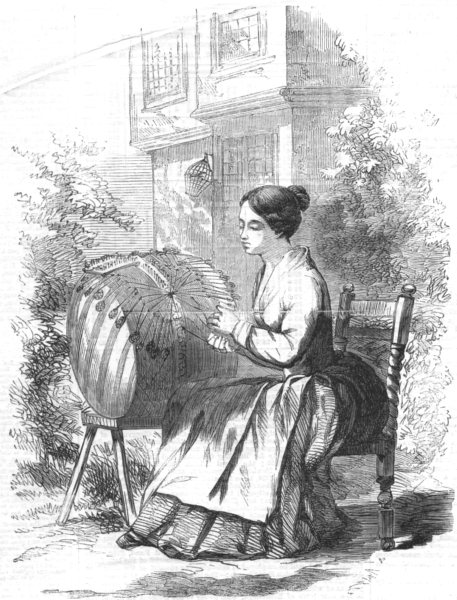Silverstone, now best known for its racing circuit, lies at the heart of the ancient forest of Whittlewood on the Northamptonshire-Buckinghamshire border. There is an academic explanation why forest communities took up craft manufactures like lace, but we’ll not go into that here. Certainly Silverstone was a lace village until the late nineteenth century.

John Edward Linnell (1842-1919), born in Silverstone, vicar of Pavenham. Image from ‘Old Oak’ (1932)
John Edward Linnell (1842-1919) grew up in Silverstone, or ‘Silson’ in the local parlance. Years later, when serving as vicar of Pavenham near Bedford (another lace village), he wrote an account of his childhood. Linnell came to holy orders by a round-about route and his memoirs are more robust than one might expect from a Victorian clergyman. While many of his peers repressed the rough games that characterised rural popular culture, Linnell commemorated them. He was also interested in more aesthetic pursuits such as ballad singing. One of the singers he mentions was a lacemaker, Sall, who kept house with her brother Simon, the sexton. We quote this section in full, including a verse of one of Sall’s songs. The pair
lived in a large, lone, thatched cottage that stood on the edge of an orchard. They always had a wood fire on the hearth of their living-room, and half-way up the top of the wide, open chimney hung flitches of bacon and hams, which had been sent by their wealthier neighbours to be smoked and dried. Around a window that opened from the chimney-corner into the garden there were built into the wall a number of old Dutch tiles said to have once belonged to a mansion that had vanished from Silson centuries back, possibly the royal residence I have already mentioned. The shelves were loaded with the choicest of old china, while here and there hung a time-stained print depicting a battle-scene. When I was a boy, it was one of my greatest delights of my life to drop in on them of a winter’s night, when the wind was howling among the trees outside and the sparks were flying up the chimney to lose themselves in the darkness above, and hear them tell their stories of bygone days. It was a picture many an artist would have loved to paint. Simon used to sit on a low, flag-bottomed chair, his body bent forward over the hearth so that he could better replenish the fire. Sall, with her lace pillow before her, would jangle her bobbins and place her pins with her long, bony fingers in the light of a tallow candle whose rays passed through a tall water-bottle and fell softly on her parchment. The two knew all the legends and traditions of the countryside, and it’s from them I gleaned many of the incidents I now relate sixty years after.
Sir Walter Scott once declared that nothing was more dramatically effective than an old murder ballad. With anyone like Sall to recite it, I can well believe him. The murderer, the victim, the grave, and the hanging were brought before our eyes as the verses fell from her lips. To the ordinary reader the following lines would seem mere jingle: —
‘One lonely night, as I sat high,
Instead of one there two pass’d by.
The boughs did bend, my soul did quake,
To see the hole that Fox did make.’
To her they presented part of a tragedy more real than Macbeth’s to lovers of Shakespeare, though the heroine was only a humble serving-maid. She, it seemed, had arranged to meet her lover by moonlight in a spinney near her master’s house. First at the trysting place, she climbed a fir-tree to give the laggard a fright when he should appear. After a long wait she heard footsteps and voices and, looking down, saw her lover enter the glade accompanied by a man carrying a spade. Not daring to speak, she watched them while they dug a deep hole just beneath her. Then the truth dawned on her; she was to be murdered, and it was her grave they were digging. At last their task was finished, and the villains impatiently awaited her arrival. But they were to be disappointed, for, though trembling in every limb with terror, she did not reveal her presence. Eventually they departed, and she descended the tree, fled back to her master’s house, and told what she had seen. An alarm was raised, her lover, Fox, whose name seemed well suited to his character, was arrested, confessed to his evil intentions, and was hanged. ‘An’ sarve him right!’ Simon would grunt, when Sall had left him swinging ‘from the gallows tree so high.’[1]
When Linnell’s memoirs appeared posthumously in 1932, this particular verse had already been recorded from lacemakers on several occasions, and now it has its own entry in the Roud Folksong Index as RN17769. It was frequently identified as a ‘lace tell’. A report in The Leighton Buzzard Observer for 4 April 1893 explained that
one of the most curious features in connection with this trade was the songs of the lacemakers, known locally as lace tells, or lace tellings. These consisted of doggrel [sic] verses which remind one very forcibly of the nursery ditties that delight the juvenile mind. The proficiency of the worker was estimated by the number of pins stuck in a given time, and the singing of these tells assisted the counting and kept them together. These songs possess no merit as literary productions, if such they may be called, but they form a remarkable and interesting survival of a condition of things which has practically passed away. We give a few of the more striking.
‘Nineteen miles as I sat high,
Looking for one as he passed by;
The boughs did bend, the leaves did shake,
See what a hole the fox did make!
The fox did look, the fox did see,
Digging a hole to bury me;
I saw one that ne’er saw me,
I saw a dark lantern tied to a tree.’
The allusion here is to an intended murder. A young man wishing to rid himself of his sweetheart had determined to take her life; and, with the intention of hiding all traces of the crime, he busied himself with digging her grave near the spot where they were to meet. He was turned from his wicked purpose by observing some person either up a tree or standing behind him.[2]
This lace tell was also noted by Thomas Wright, among others.[3] It is one of the few tells for which we possess a tune because the folksong collector Fred Hamer (the husband of the lace teacher Margaret Hamer) recorded a version from a Mrs White of Cranfield in Bedfordshire.[4]

James Orchard Halliwell (1820-1889), Shakespearean and nursery rhyme collector. Image from Wikipedia Commons
Lace Tells were often cut down and mashed up versions of longer ballads, and the implication of Linnell’s account is that the entire narrative was sung. However, no full version of the story in ballad form has been discovered in tradition.[5] So it is more likely that this verse was meant as a sung element in a longer prose narrative, what is known as a ‘cante-fable’.
The whole story, including the verse, has also been recorded on a number of occasions, the first in James Orchard Halliwell’s Popular Rhymes and Nursery Tales in 1849. This book has a complicated publishing history: it was the sequel to the author’s Nursery Rhymes of England which first appeared in 1842, although the verse about ‘the hole the fox did make’ only appeared in the 1846 edition of that title.[6] Both verse and story were said by Halliwell to have been obtained in Oxfordshire.
Many years ago there lived at the University of Oxford a young student, who, having seduced the daughter of a tradesman, sought to conceal his crime by committing the more heinous one of murder. With this view, he made an appointment to meet her one evening in a secluded field. She was at the rendezvous considerably before the time agreed upon for their meeting, and hid herself in a tree. The student arrived on the spot shortly afterwards, but what was the astonishment of the girl to observe that he commenced digging a grave. Her fears and suspicions were aroused, and she did not leave her place of concealment till the student, despairing of her arrival, returned to his college. The next day, when she was at the door of her father’s house, he passed and saluted her as usual. She returned his greeting by repeating the following lines:
One moonshiny night, as I sat high,
Waiting for one to come by,
The boughs did bend; my heart did ache
To see what hole the fox did make.
Astounded by her unexpected knowledge of his base design, in a moment of fury he stabbed her to the heart. This murder occasioned a violent conflict between the tradespeople and the students, the latter taking part with the murderer, and so fierce was the skirmish, that Brewer’s Lane, it is said, ran down with blood. The place of appointment was adjoining the Divinity Walk, which was in time past far more secluded than at the present day, and she is said to have been buried in the grave made for her by her paramour.[7]
Even in the versions given so far one can see that the verse was more stable than the story that explains it. In the one Sall told to Linnell the would-be assassin ended on the gallows, in the Olney version he was discovered and fled, while in the Oxford version he murders the girl but not at the place and time he had planned. In another version, sent in to Notes and Queries in 1887 by Thomas Ratcliff of Worksop, the servant girl lured by her false lover to the woods is so frightened by the grave she sees him digging that she falls in a faint from the tree, and this in turn frightens off the would-be murderers.[8]
We’ll give this agglomeration of stories the general title ‘One Moonshiny Night’, as used in Notes and Queries, to distinguish this group from a variety of other traditional tales that feature a young woman who accidentally learns that her suitor plans to murder her and later confronts him with this knowledge. In folklore studies the generic title for this plot type is ‘The Robber Bridegroom’, tale type number ATU 955. It is an enormously popular narrative, with variants found in many cultures.[9] It is has also inspired many writers, including Eudora Welty’s 1942 novella The Robber Bridegroom and, more relevant to lacemakers, Henri Pourrat’s four volume novel Gaspard des Montagnes (1922-1931). (Pourrat’s literary output drew heavily on his career as a folklorist around Ambert: his most forthcoming narrators were lacemakers.)[10] The best known English version is ‘Mister Fox’, which John Brickdale Blakeway (1765-1821) wrote from memory, having been told it in his youth by a great-aunt, and sent by him to the Shakespearean scholar Edmond Malone (1741-1812). Malone then included it in his notes to the play Much Ado About Nothing. Why? Because it elucidates the line Benedick says to Claudio Act 1 Scene 1: ‘Like the old tale, my lord: it is not so, nor ‘twas not so; but, indeed, God forbid it should be so’, the very words the murderer Mister Fox says to his would-be victim, Lady Mary, when she challenges him with her knowledge of his plans.[11] However, while the name ‘Mister Fox’ would imply some connection to ‘One Moonshiny Night’, the verse itself does not occur in Blakeway’s version… and any further pursuit of the relationship between these narratives will take us too far from our lacemakers’ tell.

Archdeacon Hugh Owen (left) and Reverend John Brickdale Blakeway (right). Painted by Philip Corbet. Blakeway collected the folktale ‘Mister Fox’. Image from Ludlow Museum and reproduced by permission of Shropshire Council, Shropshire Museums
The popularity of the verse must owe something to its diffusion in printed form. The first one that we have found appears in The Trial of Wit or, A New Riddle Book, published in Glasgow in 1782 and reprinted there in 1789 and 1795. Here the verse is presented as a riddle:
As I went out in a moonlight night,
To keep from harm I took the height,
I set my back against the moon,
I look’d for one and saw two come.
The boughs did bend the leaves did shake,
I saw the hole the Fox did make.
It was a maid had a sweetheart whose name was Fox: she saw him and another come to make her grave, while she sat on a tree.[12]
The same riddle appeared in Tom Thumb’s Royal Riddle Book for the Trial of Dull Wits, printed at Falkirk in 1788, and then again in Stirling in 1801.[13] It is not implausible that there were many other editions of these riddle books, in England, Ireland and North America as well, but it is also possible that copies were carried to these regions from Scotland by ‘flying stationers’. Such small books were printed to be sold by pedlars; they were ephemeral and few have survived. It is unlikely that the story or the verse originated in these pamphlets because the effect of the riddle depends entirely on some pre-existing knowledge of the narrative. Nonetheless, the existence of print versions may have had a mnemonic effect.
The verse is in the first person, spoken by the intended victim. In most full versions of the story she uses this elliptical account of her experience to inform her would-be murderer that she has discovered his plan. Only the assassin would understand the meaning of her words. Choosing this riddle form to confront him is not necessary to the plot, but such circumlocutions are a common feature of oral cultures. In face-to-face communities people, especially the relatively weak like servant maids, had to be careful how they spoke. They therefore developed the art of delivering their message in forms that were opaque to those who were not involved, and inoffensive to those who were. Texts were meaningful to those in the know, but apparent nonsense to outsiders. Their incomprehensibility, ‘a mere jingle’ to quote Linnell, was intentional.
The riddle is a typical example of such genres that create a bond of shared understanding between insiders while remaining obscure to outsiders. Lace tells are another. As Gerald Porter explains, in performance as a lace tell the frame story that makes sense of the verse disappears: the identity of the speaker and the diggers, and the relationship between them is unclear. Yet the whole narrative remained implicit, completed in the minds of listeners who likely already knew it. This process creates an ‘insider group’ – in this case the lacemakers – bonded by their shared knowledge, their shared ability to interpret the riddle.[14] By speaking the riddle in the first person the lacemakers identify with the would-be victim, and here we encounter another common element to be found in the work culture of lacemakers in other countries too: men were a threat, especially strangers, and so young women had to be on their guard. Narrative and song were means to inculcate important life lessons.
[1] John Edward Linnell, Old Oak: The Story of a Forest Village, ed. Charles Linnell (London, 1932), pp. 48-51.
[2] ‘Among the Buckinghamshire Pillow-Lace Makers. By our special correspondent’, The Leighton Buzzard Observer, Tuesday 4 April 1893, p. 6. Precisely the same wording is given in Oliver Ratcliff and Hebert Brown, Olney: Past and Present (Olney, 1893).
[3] Thomas Wright, The Romance of the Lace Pillow (Olney, 1919), pp. 182-3.
[4] Vaughan Williams Memorial Library, Fred Hamer manuscripts, FH/4/4/124: recorded from Mrs White of Cranfield: ‘I saw them that never saw me,/ I saw a lantern tied to a tree,/ The boughs did shake and I did quake,/ To see what a hole the fox did make./ The fox did roar and I did see,/ The fox made that hole to bury me.’
[5] The ballad ‘Oh Bring With You Your Dowry Love’, which has been commercially recorded on a few occasions, is based on this story, but appears to have been written by the folk-song collector Frank Kidson to provide a context for the verse about ‘the hole the fox did make’, which he heard sung by Kate Thompson in Knaresborough in 1891. His ballad version was then included in English Peasant Songs (1929). The verse also occurs in a version of ‘The Cottage in the Wood’, sung by Martin Carthy, but this was his own addition to a much better known song (Roud Number 608) about a pedlar calling at an isolated house, but which usually ends happily in a marriage: see https://mainlynorfolk.info/martin.carthy/songs/thecottageinthewood.html
[6] James Orchard Halliwell, The Nursery Rhymes of England, Collected Chiefly from Oral Tradition 4th edition (London, 1846), p. 3.
[7] James Orchard Halliwell, Popular Rhymes and Nursery Tales (London, 1849), pp. 47-50.
[8] Thomas Ratcliff, ‘One Moonshiny Night’, Notes and Queries 7th series 3, 19 March 1887, pp. 229-30. Several other versions – from Lincolnshire, Yorkshire, Gloucestershire, Ireland and New England – were submitted to that journal in the same year: F.C. Birkbeck Terry, ‘One Moonshiny Night’, Notes and Queries 7th series 3, 19 February 1887, p. 149; S.O. Addy, Notes and Queries 7th series 3, 19 March 1887, p. 230; D.F. ‘One Moonshiny Night’, Notes and Queries 7th series 3, 21 May 1887, p. 410; other replies were submitted by ‘St Swithin’ (pseud. Eliza Gutch), T.H. Smith and M.L. Ferrar. Sidney Addy also published a longer version under the title ‘The Girl Who Got Up The Tree’ in Household Tales with Other Traditional Remains, Collected in the Counties of Yorkshire, Lincolnshire, Derby, and Nottingham (London, 1895), pp. 10-11.
[9] For some examples, see the ever useful website of Professor Ashliman; http://www.pitt.edu/~dash/type0955.html
[10] We will return to Pourrat in future blogs, but for his debt to lacemakers see Bernadette Bricout, Le Savoir et la saveur. Henri Pourrat et Le Trésor des contes (Paris, 1992).
[11] The tale is also apparently quoted in Spencer’s The Fairie Queen. On these literary connections see the blog by Katherine Langrish: http://steelthistles.blogspot.co.uk/2016/09/be-bold-be-bold-but-not-too-bold.html
[12] The Trial of Wit, or, a New Riddle-Book. Some of which were Never before Published (Glasgow, 1782).
[13] Tom Thumb’s Royal Riddle Book: For the Trial of Dull Witts (Falkirk, 1788); Tom Thumb’s Royal Riddle Book: For the Trial of Dull Wits (Stirling, 1801).
[14] Mary-Ann Constantine and Gerald Porter Fragment and Meaning in Traditional Song: From the Blues to the Baltic (Oxford, 2003), pp. 69-71.































